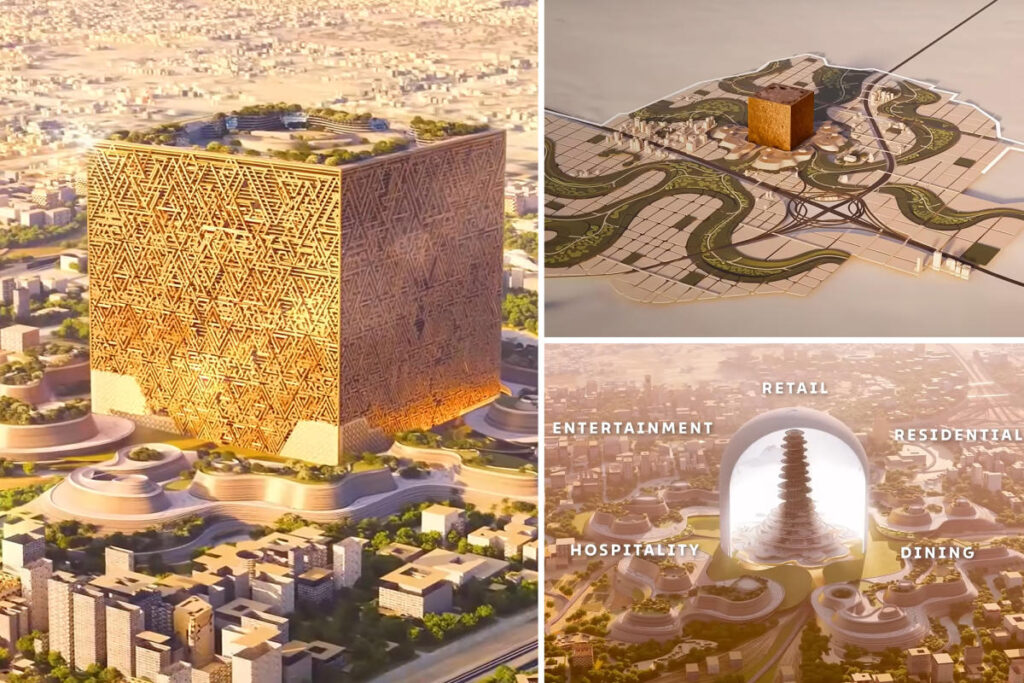In a groundbreaking ceremony in Riyadh, Saudi Arabia, the construction of what is expected to be the “world’s largest building,” known as The Mukaab, has officially commenced. With a staggering budget of $50 billion, this ambitious project embodies a broader trend of futuristic developments sweeping across the Arab nation. The Mukaab is designed to dramatically redefine Riyadh’s skyline, standing at an impressive 1,300 feet high and 1,200 feet wide, boasting enough space to encompass 20 Empire State Buildings. This architectural marvel is envisioned as a self-contained urban center, featuring a combination of fine dining, retail spaces, offices, and restaurants within its 2 million square feet of floor space.
The Mukaab will not only serve as a commercial hub but also as a residential space, including 104,000 residential units and 9,000 hotel rooms. It is characterized as a “human-first” project, aimed at enhancing the quality of life for its inhabitants and visitors by incorporating green spaces accessible within a 15-minute walk from any point in the cube. The New Murabba Development Company, responsible for this massive undertaking, insists on utilizing artificial intelligence to create immersive experiences. The exterior will be adorned with gigantic screens reminiscent of Las Vegas attractions, adding a unique visual aspect to the structure.
Drawing inspiration from the natural environment and traditional architecture, The Mukaab aims to harmonize modern design with local culture. The surrounding areas are modeled after wadis—Arabic for riverbeds—creating winding pathways that mimic desert streams. This nod to nature is complemented by elements of the Najdi architectural style, featuring mudbrick constructions and courtyards that capture the essence of the region’s historical building techniques. The ambitious project seeks not only to provide cutting-edge facilities but also to foster a sense of community and connection with the local landscape.
Economically, the Mukaab is anticipated to have a significant impact, projected to contribute over $51 billion to Saudi Arabia’s non-oil GDP and creating approximately 334,000 jobs. The construction phase will employ around 900 workers, with plans for completion by 2030. This initiative is part of Crown Prince Mohammed bin Salman’s broader vision to modernize the Saudi economy through the “Saudi Vision 2030” program, which aims to reduce the nation’s reliance on oil revenues while diversifying its economic landscape and enhancing public service sectors.
Crown Prince Salman has outlined a series of ambitious projects that extend beyond The Mukaab. These include a floating port city named “Oxagon” on the Red Sea coast, a mountain tourism destination dubbed “Trojena,” and a revolutionary city called “NEOM” in the northwest, designed to operate entirely on renewable energy. Each of these projects, like The Mukaab, falls under the overarching goal of transforming Saudi Arabia into a modern metropolis while promoting sustainable development and diversifying its economy.
In addition to a focus on social and economic transformation, The Mukaab and its companion projects reflect a strategic shift towards innovative urban planning rooted in local culture and environment. As these monumental endeavors unfold, they promise to reshape not only the landscape of Riyadh but also the cultural and economic fabric of Saudi Arabia as it navigates its future in a post-oil world. The Mukaab stands as a beacon of this ambition, signaling a new era of growth and modernization for the kingdom, with an eye toward sustainability and community-centered design.

